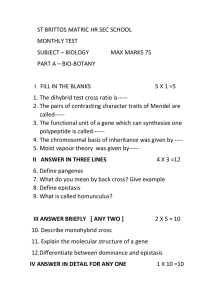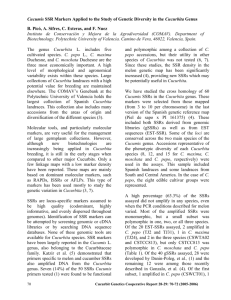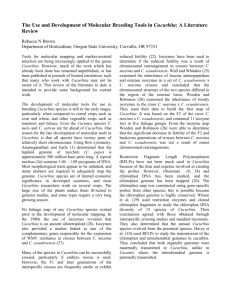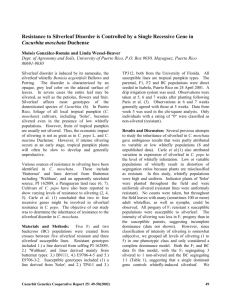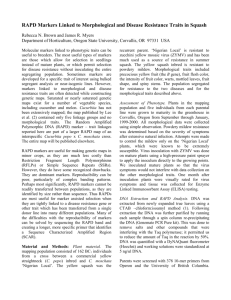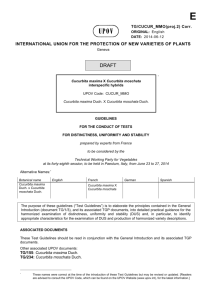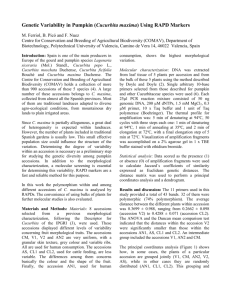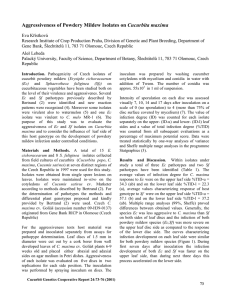Cucurbita Review Rebecca N Brown
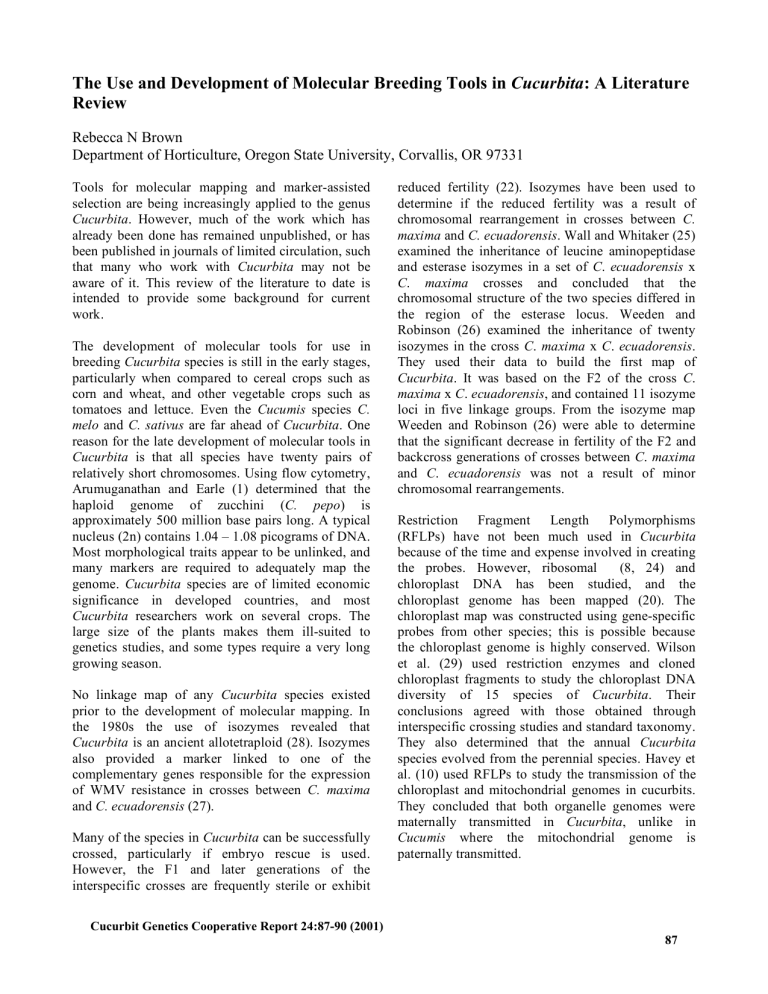
The Use and Development of Molecular Breeding Tools in Cucurbita : A Literature
Review
Rebecca N Brown
Department of Horticulture, Oregon State University, Corvallis, OR 97331
Tools for molecular mapping and marker-assisted selection are being increasingly applied to the genus
Cucurbita . However, much of the work which has already been done has remained unpublished, or has been published in journals of limited circulation, such that many who work with Cucurbita may not be aware of it. This review of the literature to date is intended to provide some background for current work.
The development of molecular tools for use in breeding Cucurbita species is still in the early stages, particularly when compared to cereal crops such as corn and wheat, and other vegetable crops such as tomatoes and lettuce. Even the Cucumis species C.
melo and C.
sativus are far ahead of Cucurbita . One reason for the late development of molecular tools in
Cucurbita is that all species have twenty pairs of relatively short chromosomes. Using flow cytometry,
Arumuganathan and Earle (1) determined that the haploid genome of zucchini ( C.
pepo ) is approximately 500 million base pairs long. A typical nucleus (2n) contains 1.04 – 1.08 picograms of DNA. reduced fertility (22). Isozymes have been used to determine if the reduced fertility was a result of chromosomal rearrangement in crosses between C. maxima and C. ecuadorensis . Wall and Whitaker (25) examined the inheritance of leucine aminopeptidase and esterase isozymes in a set of C . ecuadorensis x
C . maxima crosses and concluded that the chromosomal structure of the two species differed in the region of the esterase locus. Weeden and
Robinson (26) examined the inheritance of twenty isozymes in the cross C . maxima x C . ecuadorensis .
They used their data to build the first map of
Cucurbita . It was based on the F2 of the cross C . maxima x C . ecuadorensis , and contained 11 isozyme loci in five linkage groups. From the isozyme map
Weeden and Robinson (26) were able to determine that the significant decrease in fertility of the F2 and backcross generations of crosses between C . maxima and C . ecuadorensis was not a result of minor chromosomal rearrangements.
Restriction Fragment Length Polymorphisms
(RFLPs) have not been much used in Cucurbita
Most morphological traits appear to be unlinked, and many markers are required to adequately map the genome. Cucurbita species are of limited economic significance in developed countries, and most
Cucurbita researchers work on several crops. The large size of the plants makes them ill-suited to genetics studies, and some types require a very long growing season.
No linkage map of any Cucurbita species existed prior to the development of molecular mapping. In the 1980s the use of isozymes revealed that
Cucurbita is an ancient allotetraploid (28). Isozymes also provided a marker linked to one of the complementary genes responsible for the expression of WMV resistance in crosses between C. maxima and C. ecuadorensis (27).
Many of the species in Cucurbita can be successfully crossed, particularly if embryo rescue is used.
However, the F1 and later generations of the interspecific crosses are frequently sterile or exhibit because of the time and expense involved in creating the probes. However, ribosomal (8, 24) and chloroplast DNA has been studied, and the chloroplast genome has been mapped (20). The chloroplast map was constructed using gene-specific probes from other species; this is possible because the chloroplast genome is highly conserved. Wilson et al. (29) used restriction enzymes and cloned chloroplast fragments to study the chloroplast DNA diversity of 15 species of Cucurbita . Their conclusions agreed with those obtained through interspecific crossing studies and standard taxonomy.
They also determined that the annual Cucurbita species evolved from the perennial species. Havey et al. (10) used RFLPs to study the transmission of the chloroplast and mitochondrial genomes in cucurbits.
They concluded that both organelle genomes were maternally transmitted in Cucurbita , unlike in
Cucumis where the mitochondrial genome is paternally transmitted.
Cucurbit Genetics Cooperative Report 24:87-90 (2001)
87
Lee et al. (17) developed a RAPD map of an F2 population of a C.
pepo x C. moschata interspecific hybrid. They screened the parents with 70 10-mer primers from the University of British Columbia
(UBC 501-570); 15 of the primers were polymorphic between the parents. These fifteen primers were used to amplify DNA from 40 F2 individuals, resulting in
58 RAPD bands. Forty-seven reproducible markers were used to build the map; 28 markers were mapped into five linkage groups. No morphological traits or other types of markers were included on the map.
The map of Lee et al. (17) was small, based on a small number of progeny, and was published in the
Korean Journal of Horticulture, with the result that it is not well known in the Cucurbita community.
Furthermore, they selected arbitrary identifiers for the markers on their map, rather than following the standard practice of identifying the markers by the primer and the band size in base pairs. This further prevents comparisons between their map and other
Cucurbita maps. The map of Lee et al (17) is currently the only published molecular map of
Cucurbita . Data were collected for a random amplified polymorphic DNA (RAPD) map on a C. maxima x C. ecuadorensis population, but the map was never published (N. Weeden, personal communication).
RAPDs and other molecular marker technologies have been used to do DNA fingerprinting analysis within and between Cucurbita species. Jeon et al.
(11) used RAPDs to distinguish among Korean cultivars of C.
pepo and C. moschata , while Youn et al. (30) used RAPDs to study the genetic relationships among South Korean landraces of C. moschata . Stachel et al. (23) used RAPDs to estimate genetic diversity among commercial inbred lines of
Austrian oilseed pumpkin, C.
pepo var. styriaca .
Gwanama et al (9) used RAPDs to determine the genetic variability present in the C. moschata landraces of south-central Africa. Baranek et al. (2) used RAPDs to study the genetic diversity within and between species of C. pepo , C. moschata , and C. maxima . All the researchers found RAPDs to be effective for determining the relatedness of different
Cucurbita accessions. Katzir et al. (13) used microsatellite-anchored sequences as primers (ISSR) to classify cultivars of C.
pepo . No microsatellites specifically designed for Cucurbita have been published, but polymorphisms among Cucurbita pepo accessions have been detected using SSRs developed for Cucumis (14, 15).
Cucurbit Genetics Cooperative Report 24:87-90 (2001)
Polymorphism levels in Cucurbita are moderate.
Stachel et al. (23) found 116 polymorphic markers by screening a set of 20 inbred lines of oilseed pumpkin
( C.
pepo var. styriaca ) with 34 RAPD primers.
Baranek et al.(2) found 42.5% marker polymorphism among six Austrian C.
pepo genotypes. Katzir et al. found that 14% of the Cucumis SSR primers (15) and
82% of ISSR markers (13) were polymorphic among cultivar groups of C.
pepo . Youn et al. (30) found that 18.6% of markers were polymorphic among C. moschata landraces. Brown and Myers (4) found
14% marker polymorphism between temperate and tropical C. moschata lines. Baranek et al. (2) found
64.1% marker polymorphism among a geographically disparate collection of C. moschata accessions. They found 55.9% marker polymorphism among a disparate collection of C. maxima .
Marker assisted selection is little-used in Cucurbita breeding. Brown and Myers have identified RAPD markers linked to several morphological traits in an interspecific cross between a C. pepo summer squash and C.
moschata ‘Nigerian Local’ (see article in this issue) but they are not yet in a form that will be directly useful to breeders. Two groups have been working on identifying molecular markers linked to
ZYMV resistance from ‘Nigerian Local’ introgressed into C. pepo (2, 19) but no markers have been published.
A number of Cucurbita genes have been characterized at the molecular level and cloned.
However, this work has been done entirely by molecular geneticists interested in the control and functioning of pathways common to many plants.
Thus the genes cloned have been of little direct use to squash breeders. Researchers in the laboratory of G.
A. Thompson at the University of Arizona have studied and cloned the genes encoding important proteins in the phloem transport system of C. maxima
(3, 6, 18). Other recently cloned genes in Cucurbita include a calcium-dependent protein kinase from zucchini (7), a class-3 chitinase (16), a glyoxysomal malate dehydrogenase (12), and an anionic peroxidase (5). Cloning of these types of pathwaycontrolling genes from Cucurbita has been greatly facilitated by the availability of probes and sequence information from other species where genes with the same function have already been cloned.
88
It is apparent from the literature that molecular genetics is just beginning in Cucurbita . As the genome is mapped, it should be possible to identify markers for many useful traits. Markers could be particularly useful for tagging the complementary virus-resistance genes, such as Zym-2 and Zym-3 (21) and ensuring that they are transferred during backcrossing. Molecular maps will also allow further investigation into the evolution and species relationships in Cucurbita , and between Cucurbita and other cucurbits.
Literature Cited
1.
Arumuganathan, K and ED Earle, 1991, Nuclear
DNA content of some important plant species,
Plant Molecular Biology Reporter 9:208-218.
2.
Baranek, M., G. Stift, J. Vollmann and T. Lelley,
2000, Genetic diversity within and between the species Cucurbita pepo , C. moschata , and C. maxima as revealed by RAPD markers, CGC
Rpt. 23:73-77.
3.
Bostwick, DE, MI Skaggs and GA Thompson,
1994, Organization and characterization of
Cucurbita phloem lectin genes. Plant Mol. Bio.
26:887-897.
4.
Brown, R. and JR Myers, 2000, Searching for molecular markers linked to ZYMV resistance in squash. CGC Rpt, 23:69-70.
5.
Carpine, S., M. Crevecoeur, H. Grepin and C.
Penel, 1999, Molecular cloning and tissuespecific expression of an anionic peroxidase in zucchini, Plant Physiol. 120:799-810.
6.
Clark, AM, KR Jacobaen, DE Bostwick, JA
Dannenhoffer, MI Skaggs and GA Thompson,
1997, Molecular characterization of a phloemspecific gene encoding the filament protein,
Phloem Protein 1 (PP1), from Cucurbita maxima .
Plant Journal 12:49-61.
7.
Ellard-Ivey, M, RB Hopkins, TJ White and TL
Lomax, 1999, Cloning, expression and Nterminal myristoylation of CpCPK1, a calciumdependent protein kinase from zucchini
( Cucurbita pepo L .), Plant Mol. Bio. 39:199-208.
8.
Ganal, M. and V. Hemleben, 1986, Comparison of the ribosomal RNA genes in four closely related Cucurbitaceae. Pl. Syst. Evol. 154:63-77.
9.
Gwanama, C, MT Labuschagne and AM Botha,
2000, Analysis of genetic variation in Cucurbita moschata by random amplified polymorphic
DNA (RAPD) markers, Euphytica 113:19-24.
10.
Havey, MJ, JD McCreight, B. Rhodes and G.
Taurick, 1998, Differential transmission of the
Cucumis organellar genomes, Theor. Appl.
Genet. 97:122-128.
11.
Jeon, HJ; CG Been; KH Hong; YH Om and BD
Kim, 1994, Identification of Cucurbitaceae cultivars by using RAPD markers. J. Korean Soc
Hort Sci 35:449-456.
12.
Kato, A., Y. Takeda-Yoshikawa, M. Hayashi, M.
Kondo, I. Hara-Nishimura and M. Nishimura,
1998, Glyoxysomal malate dehydrogenase in pumpkin: Cloning of a cDNA and functional analysis of its presequence, Plant Cell Physiol.
39:186-195.
13.
Katzir, N, E. Leshzeshen, G. Tzuri, N. Reis, Y.
Danin-Poleg and HS Paris, 1998, Relationships among accessions of Cucurbita pepo based on
ISSR analysis, in JD McCreight, ed.
Cucurbitaceae ’98, ASHS Press. pp.331-335.
14.
Katzir, N, Y. Danin-Poleg, G. Tzuri, Z. Karchi,
U. Lavi and PB Cregan, 1996, Length polymorphism and homologies of microsatellites in several Cucurbitaceae species, Theor. Appl.
Genet. 93:1282-1290.
15.
Katzir, N, Y. Tadmor, G. Tzuri, E. Leshzeshen,
N. Mozes-Daube, Y. Danin-Poleg and HS Paris,
2000, Further ISSR and preliminary SSR analysis of relationships among accessions of Cucurbita pepo . Acta Hortic. 510:433-439.
16.
Kim, MG, KO Lee, NE Cheong, YO Choi, JH
Jeong, MJ Cho, SC Kim and SY Lee, 1999,
Molecular cloning and characterization of a class
III chitinase in pumpkin leaves, which strongly binds to regenerated chitin affinity gel. Plant Sci.
147:157-163.
17.
Lee, YH, HJ Jeon, KH Hong and BD Kim, 1995,
Use of random amplified polymorphic DNAs for linkage group analysis in interspecific hybrid F2 generation of Cucurbita . J. Korean Soc. Hort.
Sci. 36:323-330.
18.
Leineweber, K.; A. Schulz, and GA Thompson,
2000, Dynamic transitions in the translocated phloem filament protein. Aust. J. Plant Physiol.
27:733-741.
Cucurbit Genetics Cooperative Report 24:87-90 (2001)
89
19.
Lelley, T and S. Henglmüller, 2000, Breeding for
ZYMV tolerance of seed-oil pumpkin ( Cucurbita pepo var. styriaca ) in Austria using molecular markers, CGC Rpt. 23:117-119.
20.
Lim, H, I. Gounaris, RC Hardison and CD Boyer
1990. Restriction site and genetic map of
Cucurbita pepo chloroplast DNA. Curr Genet
18:273-275.
21.
Paris, HS and S. Cohen 2000 Oligogenic inheritance for resistance to Zucchini yellow mosaic virus in Cucurbita pepo , Ann. Appl. Biol.
136:209-214.
22.
Robinson, RW and Decker-Walters, DS. 1997.
Cucurbits. CAB International.
23.
Stachel, M., G. Csanadi, J. Vollmann and T.
Lelley, 1998, Genetic diversity in pumpkins
( Cucurbita pepo L.) as revealed in inbred lines using RAPD markers. CGC Rpt. 21:48-50.
24.
Torres Ruiz, RA, and V. Hemleben, 1991, Use of ribosomal DNA spacer probes to distinguish cultivars of Cucurbita pepo L. and other
Cucurbitaceae. Euphytica 53:11-17.
25.
Wall, JR and TW Whitaker, 1971, Genetic control of leucine aminopeptidase and esterase isozymes in the interspecific cross Cucurbita ecuadorensis x C. maxima . Biochem. Genet.
5:223-229.
26.
Weeden, NF and RW Robinson, 1986, Allozyme segregation ratios in the interspecific cross
Cucurbita maxima x C. ecuadorensis suggest that hybrid breakdown is not caused by minor alteration in chromosome structure. Genetics
114:593-609.
27.
Weeden, NF, RW Robinson and F. Ignart, 1984,
Linkage between an isozyme locus and one of the genes controlling resistance to watermelon mosaic virus 2 in Cucurbita ecuadorensis , CGC
Rpt. 7:86-87.
28.
Weeden, NF. 1984. Isozyme studies indicate that the genus Cucurbita is an ancient tetraploid.
CGC Rpt. 7:84-85.
29.
Wilson, HD, J. Doebley and M. Duvall, 1992,
Chloroplast DNA diversity among wild and cultivated members of Cucurbita
(Cucurbitaceae), Theor Appl. Genet. 84:859-865.
30.
Youn, SJ; HD Chung; SJ Youn; and HD Chung,
1998, Genetic relationship among the local varieties of the Korean native squashes
( Cucurbita moschata ) using RAPD technique. . J.
Korean Soc. Hort. Sci. 39:517-521. (in Korean with English summary)
Cucurbit Genetics Cooperative Report 24:87-90 (2001)
90
